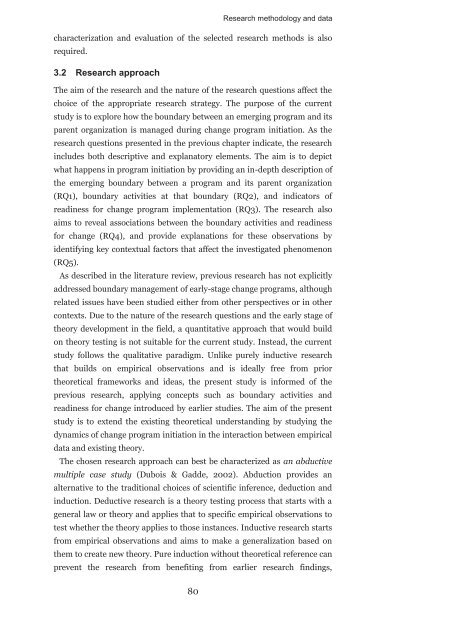Boundary activities and readiness for ... - Projekti-Instituutti
Boundary activities and readiness for ... - Projekti-Instituutti
Boundary activities and readiness for ... - Projekti-Instituutti
Create successful ePaper yourself
Turn your PDF publications into a flip-book with our unique Google optimized e-Paper software.
Research methodology <strong>and</strong> data<br />
characterization <strong>and</strong> evaluation of the selected research methods is also<br />
required.<br />
3.2 Research approach<br />
The aim of the research <strong>and</strong> the nature of the research questions affect the<br />
choice of the appropriate research strategy. The purpose of the current<br />
study is to explore how the boundary between an emerging program <strong>and</strong> its<br />
parent organization is managed during change program initiation. As the<br />
research questions presented in the previous chapter indicate, the research<br />
includes both descriptive <strong>and</strong> explanatory elements. The aim is to depict<br />
what happens in program initiation by providing an in-depth description of<br />
the emerging boundary between a program <strong>and</strong> its parent organization<br />
(RQ1), boundary <strong>activities</strong> at that boundary (RQ2), <strong>and</strong> indicators of<br />
<strong>readiness</strong> <strong>for</strong> change program implementation (RQ3). The research also<br />
aims to reveal associations between the boundary <strong>activities</strong> <strong>and</strong> <strong>readiness</strong><br />
<strong>for</strong> change (RQ4), <strong>and</strong> provide explanations <strong>for</strong> these observations by<br />
identifying key contextual factors that affect the investigated phenomenon<br />
(RQ5).<br />
As described in the literature review, previous research has not explicitly<br />
addressed boundary management of early-stage change programs, although<br />
related issues have been studied either from other perspectives or in other<br />
contexts. Due to the nature of the research questions <strong>and</strong> the early stage of<br />
theory development in the field, a quantitative approach that would build<br />
on theory testing is not suitable <strong>for</strong> the current study. Instead, the current<br />
study follows the qualitative paradigm. Unlike purely inductive research<br />
that builds on empirical observations <strong>and</strong> is ideally free from prior<br />
theoretical frameworks <strong>and</strong> ideas, the present study is in<strong>for</strong>med of the<br />
previous research, applying concepts such as boundary <strong>activities</strong> <strong>and</strong><br />
<strong>readiness</strong> <strong>for</strong> change introduced by earlier studies. The aim of the present<br />
study is to extend the existing theoretical underst<strong>and</strong>ing by studying the<br />
dynamics of change program initiation in the interaction between empirical<br />
data <strong>and</strong> existing theory.<br />
The chosen research approach can best be characterized as an abductive<br />
multiple case study (Dubois & Gadde, 2002). Abduction provides an<br />
alternative to the traditional choices of scientific inference, deduction <strong>and</strong><br />
induction. Deductive research is a theory testing process that starts with a<br />
general law or theory <strong>and</strong> applies that to specific empirical observations to<br />
test whether the theory applies to those instances. Inductive research starts<br />
from empirical observations <strong>and</strong> aims to make a generalization based on<br />
them to create new theory. Pure induction without theoretical reference can<br />
prevent the research from benefiting from earlier research findings,<br />
80









